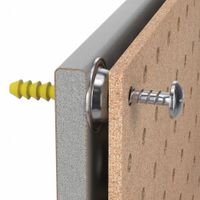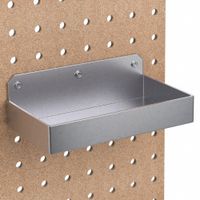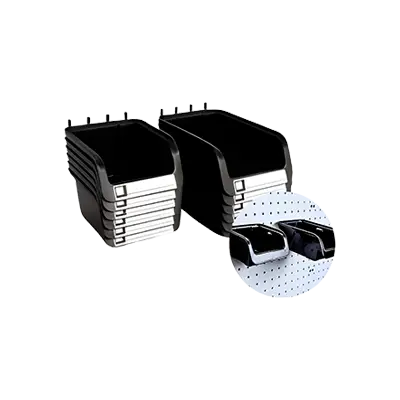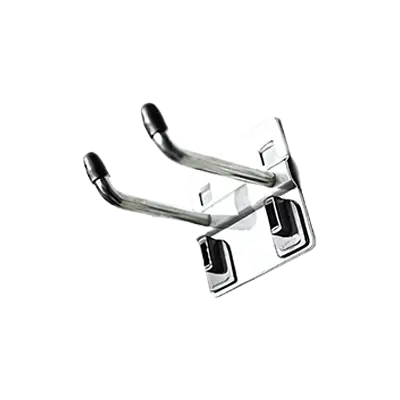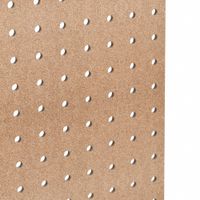Call +(254) 703 030 000 / 751 483 999 / 721 704 777
- Home
- Material Handling
- Storage Workspace
- Storage Panels Panel Racks
- Pegboard Panels Racks Accessories
.....Read More
Frequently Asked Questions
What are the standard sizes of pegboard panels?
The standard sizes of pegboard panels typically include:
1. **Dimensions**:
- 2 feet by 4 feet (24 inches by 48 inches)
- 4 feet by 4 feet (48 inches by 48 inches)
- 4 feet by 8 feet (48 inches by 96 inches)
2. **Thickness**:
- 1/8 inch
- 1/4 inch
3. **Hole Spacing**:
- 1-inch on-center spacing is the most common, meaning the center of one hole is 1 inch from the center of the next hole.
4. **Hole Diameter**:
- 1/8 inch holes for lighter items
- 1/4 inch holes for heavier items
These sizes and specifications are designed to accommodate a variety of hooks and accessories, making pegboards versatile for organizing tools, crafts, and other items.
How do you install pegboard on a wall?
1. **Gather Materials**: Pegboard, furring strips or spacers, screws, anchors, drill, level, measuring tape, pencil, saw (if cutting is needed), and a stud finder.
2. **Measure and Plan**: Determine the area where the pegboard will be installed. Measure the wall and cut the pegboard to fit if necessary.
3. **Locate Studs**: Use a stud finder to locate wall studs. Mark their positions with a pencil.
4. **Install Furring Strips/Spacers**: Cut furring strips to the height of the pegboard. Attach them vertically to the wall at the stud locations using screws. This creates a gap between the wall and pegboard for hooks.
5. **Mark Pegboard**: Position the pegboard against the furring strips. Mark where the screws will go, ensuring they align with the furring strips.
6. **Drill Holes**: Pre-drill holes in the pegboard at the marked locations to prevent splitting.
7. **Attach Pegboard**: Hold the pegboard against the furring strips. Use screws to secure it, ensuring it is level. If not aligned with studs, use wall anchors.
8. **Check Alignment**: Use a level to ensure the pegboard is straight. Adjust if necessary.
9. **Finish**: Once secured, the pegboard is ready for use. Add hooks and accessories as needed.
10. **Optional**: Paint or finish the pegboard for aesthetic purposes before installation.
What types of hooks and accessories are available for pegboards?
Pegboards offer a versatile storage solution with a variety of hooks and accessories to organize tools, crafts, and other items. Here are some common types:
1. **Straight Hooks**: Simple, straight metal hooks for hanging tools, utensils, or other items.
2. **Curved Hooks**: Designed to hold items with handles, such as hammers or wrenches.
3. **Angled Hooks**: Provide a secure hold for items that might slip off straight hooks.
4. **Double Hooks**: Feature two prongs for added stability, ideal for heavier items.
5. **Loop Hooks**: Circular or semi-circular hooks for holding items like screwdrivers or pliers.
6. **J-Hooks**: Shaped like the letter "J," perfect for hanging cords or hoses.
7. **Multi-Tool Racks**: Designed to hold multiple tools in a single accessory, often with slots or loops.
8. **Bins and Baskets**: Attach to pegboards to hold small parts, screws, or craft supplies.
9. **Shelves**: Provide a flat surface for storing larger items or organizing multiple small items.
10. **Magnetic Strips**: Hold metal tools or accessories securely in place.
11. **Tool Holders**: Specialized holders for specific tools, like drills or screwdrivers.
12. **Paper Towel Holders**: Convenient for workshops or kitchens, keeping towels within easy reach.
13. **Cord Organizers**: Designed to keep electrical cords or hoses neatly coiled and accessible.
14. **Pegboard Clips**: Secure items like papers, notes, or lightweight tools.
15. **Locking Pegs**: Provide extra security for valuable or frequently used items, preventing accidental dislodging.
These accessories can be mixed and matched to customize the pegboard for specific needs, enhancing organization and efficiency.
How much weight can a pegboard hold?
The weight a pegboard can hold depends on several factors, including the material of the pegboard, the thickness, the type of pegs used, and how the board is mounted.
1. **Material**:
- **Wooden Pegboards**: Typically made from hardboard, these can hold moderate weights. A standard 1/4-inch thick wooden pegboard can generally support around 100 pounds if properly mounted.
- **Metal Pegboards**: Made from steel or aluminum, these are more robust and can hold significantly more weight, often up to 200 pounds or more, depending on the gauge of the metal.
- **Plastic Pegboards**: These are less common for heavy-duty use but can still support light to moderate weights, usually up to 50 pounds.
2. **Thickness**: Thicker pegboards can generally support more weight. A 1/4-inch board is standard for most applications, but thicker boards can handle heavier loads.
3. **Pegs**: The type and size of pegs used also affect weight capacity. Metal hooks are stronger than plastic ones, and longer pegs can distribute weight more effectively.
4. **Mounting**: Proper installation is crucial. Pegboards should be mounted on studs or with appropriate anchors. The use of spacers or furring strips can help distribute weight more evenly and prevent the board from bending.
5. **Load Distribution**: Evenly distributing weight across the board rather than concentrating it in one area can prevent damage and increase the overall weight capacity.
In summary, a well-mounted, 1/4-inch thick wooden pegboard can typically hold around 100 pounds, while metal pegboards can support more, depending on the specific conditions mentioned above.
Can pegboards be used outdoors?
Yes, pegboards can be used outdoors, but certain considerations must be taken into account to ensure durability and functionality. Traditional pegboards are typically made from materials like wood, metal, or fiberboard, which may not withstand outdoor conditions without proper treatment.
For outdoor use, it's advisable to choose pegboards made from weather-resistant materials such as galvanized steel, stainless steel, or specially treated wood. These materials are more resistant to moisture, rust, and temperature fluctuations. Additionally, plastic pegboards made from high-density polyethylene (HDPE) or other UV-resistant plastics can be suitable for outdoor environments as they are less prone to weather-related damage.
When installing pegboards outdoors, ensure they are mounted securely to withstand wind and other environmental factors. Use rust-resistant hardware and consider applying a protective sealant to wooden pegboards to enhance their resistance to moisture and UV rays.
It's also important to consider the location where the pegboard will be installed. Placing it under a covered area or in a location with some protection from direct sunlight and rain can prolong its lifespan. Regular maintenance, such as cleaning and inspecting for signs of wear or damage, will help keep the pegboard in good condition.
In summary, while pegboards can be used outdoors, selecting the right materials and taking protective measures are crucial for ensuring their longevity and effectiveness in an outdoor setting.
How do you clean and maintain a pegboard?
To clean and maintain a pegboard, follow these steps:
1. **Remove Items**: Take off all hooks, tools, and accessories from the pegboard to ensure an unobstructed cleaning surface.
2. **Dusting**: Use a microfiber cloth or a duster to remove loose dust and debris from the surface and holes of the pegboard. For hard-to-reach areas, use a vacuum cleaner with a brush attachment.
3. **Washing**: Prepare a cleaning solution with mild dish soap and warm water. Dampen a sponge or cloth in the solution and gently wipe the pegboard. Avoid soaking the board, especially if it is made of wood, to prevent warping.
4. **Stubborn Stains**: For tougher stains, use a mixture of baking soda and water to form a paste. Apply the paste to the stain, let it sit for a few minutes, then scrub gently with a soft brush or cloth.
5. **Rinsing**: Wipe the pegboard with a clean, damp cloth to remove any soap residue. Ensure no excess water is left on the board.
6. **Drying**: Allow the pegboard to air dry completely. If possible, use a fan or open windows to speed up the drying process.
7. **Inspect and Repair**: Check for any damage, such as cracks or loose areas. Repair or replace damaged sections to maintain the board's integrity.
8. **Reorganize**: Once dry, reorganize the items on the pegboard. Consider using hooks and bins to optimize space and accessibility.
9. **Regular Maintenance**: Dust the pegboard regularly and perform a thorough cleaning every few months to keep it in good condition.
By following these steps, you can ensure your pegboard remains clean, functional, and visually appealing.
What materials are pegboards made from?
Pegboards are typically made from the following materials:
1. **Wood-based Materials:**
- **Hardboard (Masonite):** A dense, engineered wood product made from wood fibers. It is the most common material for pegboards, known for its smooth surface and durability.
- **Plywood:** Composed of multiple layers of wood veneer, plywood pegboards are sturdy and can support heavier items.
2. **Metal:**
- **Steel:** Metal pegboards are often made from steel, providing high strength and durability. They are ideal for heavy-duty applications and environments where moisture resistance is important.
- **Aluminum:** Lighter than steel, aluminum pegboards offer corrosion resistance and are suitable for both indoor and outdoor use.
3. **Plastic:**
- **Polypropylene or Polyethylene:** These plastics are used to make lightweight, moisture-resistant pegboards. They are often used in environments where exposure to water or chemicals is a concern.
- **Acrylic:** Known for its clarity and aesthetic appeal, acrylic pegboards are used in retail displays and decorative applications.
Each material offers different benefits, such as strength, moisture resistance, and aesthetic appeal, making them suitable for various applications ranging from home garages to retail displays.

